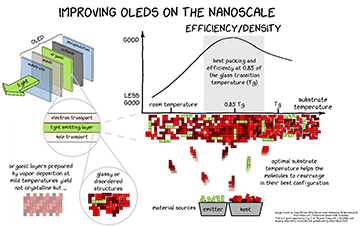Members of the research team offered an information graphic highlighting the efficiency and device-lifetime improvements possible for OLEDs by adjusting the deposition temperature of the organic layers. [Image: Joan Rafols Ribé (UAB) and Paul Anton Will (TU Dresden)] [Enlarge image]
Organic light-emitting diodes (OLEDs) are making inroads into the screens of smartphones and high-end televisions, with prospects for more growth in store (see “The Age of OLED Displays,” OPN, November 2017). But expanding their application space to demanding new markets such as automotive lighting and head-mounted displays will require further gains in OLEDs’ brightness and useful lifetime. And that requirement, in turn, has led to many late nights in academic labs spent tweaking individual device designs and envisioning new materials to get the most bang for the buck.
A research team from Spain and Germany has now offered a surprisingly simple way to boost both OLED efficiency and stability by 15 percent or possibly much more, across a range of OLED devices and without a change in materials or device architecture (Sci. Adv., doi: 10.1126/sciadv.aar8332). Instead, the multinational team’s approach focuses on adjusting the deposition temperature for the films that host the functional layers in a wide variety of OLEDs, to improve the films’ thermodynamic stability. The technique’s simplicity and generality, the researchers believe, could allow it to be leveraged “to maximize the OLED performance, no matter which specific materials are used.”
It’s the glass (transition)
The challenges in scaling up OLEDs for high-brightness applications falls out of an inverse relationship: in general, the brighter an OLED, the shorter its useful lifetime. Cracking this quandary, and building OLEDs with both high stability (for longevity) and high quantum efficiency (for brightness) has led various groups to experiment with better OLED emitter materials, or with optimizing the OLED stack through a variety of optical tricks to improve the delivery of light from the emitting layer to the outside world. These approaches, however, are specific to individual device designs, and depend heavily on cost and scale-up potential.
The research team in the recently published work, including scientists from the Universitat Autònoma de Barcelona, Spain, and the Technische Universität Dresden, Germany, looked at another variable: how the organic layers in OLEDs are actually grown. In thinking about the question, the researchers took their cue from recent work in physical vapor deposition, the predominant technique for laying down OLED layers. That work showed that “ultrastable” glass films—which sport higher thermal and kinetic stabilities and a host of other thermodynamic pluses—could be formed by slowing down the deposition process and performing it at a temperature of around 85 percent of the substrate’s glass-transition temperature (Tg).
Boosting longevity and brightness
Could those advantages benefit OLED brightness and lifetimes? To find out, the research team selected a simple OLED stack design comprising two organic layers—one serving as the both the emissive layer (EML) and the electron transport layer (ETL), and the other functioning as the hole transport layer (HTL)—that had “technically feasible” glass-transition temperatures. They used physical vapor deposition to create experimental OLEDs in red, green and blue at a number of different deposition temperatures, and tested the prototypes out for two parameters: Their external quantum efficiency (EQE) at a luminance of 100 cd/m2, and their “LT70” lifetimes—that is, the time it takes for the device luminance to fall to 70 percent of its initial value.
The team found that for both parameters, OLEDs including any of four different phosphorescent emitters and made using ultrastable glasses (that is, those deposited at temperatures close to 0.85Tg) showed a greater than 15 percent enhancement relative to reference devices made with conventionally quenched films. And for some samples the improvement was far better. The blue test OLED, for instance, sported an EQE value 163 percent higher than the reference device; green and red OLED samples clocked LT70 lifetimes some 86 to 119 percent longer (or more) than the reference samples.
For OLEDs and beyond
The researchers also undertook a detailed analysis to determine just why the use of ultrastable glass boosted the device’s quantum efficiency. They were able to rule out effects such as temperature-dependent differences in the orientation of the emitters’ dipole moments and other factors. Instead, the work suggests, the enhancement in EQE traced to differences in exciton dynamics at the nanoscale that lead to a better radiative efficiency for the emissive layer.
The team notes that, while “the enhancements presented here may seem incremental,” they can apply to a wide range of OLED stacks and device designs—and, thus, could give an extra kick to complementary efforts to ratchet up OLED performance through development of new materials. That includes so-called thermally activated delayed fluorescence (TADF) OLEDs, a technology being actively explored to improve exciton harvesting in the devices. And, the researchers believe, the use of ultrastable glasses “has a high potential to further increase the performance of various organic electronic devices and systems” well outside the realm of OLEDs.

